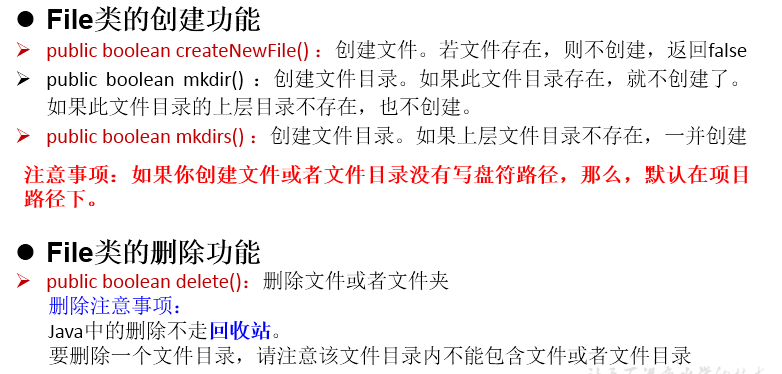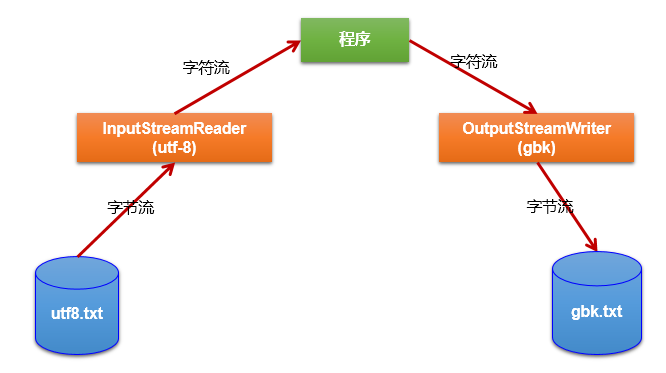IO流
File类
路径的分类
相对路径:相较于某个路径下,指明的路径。
绝对路径:包含盘符在内的文件或文件目录的路径
File类的部分方法

流的分类
按照数据分类单位:字节流(8bit)、字符流(16bit)
流向:输入流、输出流
角色:节点流、处理流
| 抽象基类 | 字节流 | 字符流 |
|---|---|---|
| 输入流 | InputStream | Reader |
| 输出流 | OutputStream | Writer |
流的体系结构:
| 抽象基类 | 节点流(文件流) | 缓冲流(处理流的一种) |
|---|---|---|
| InputStream | FileInputStream | BufferInputStream |
| OutputStream | FileOutputStream | BufferOutputStream |
| Reader | FileReader | BufferReader |
| Writer | FileWriter | BufferWriter |
节点流
FileReader/FileWriter的使用
FileReader的使用
说明点:
- read()的理解:返回读入的一个字符。如果达到文件末尾,返回-1
- 异常的处理:为了保证流资源一定可以执行关闭操作。需要使用try-catch-finally处理
- 读入的文件一定要存在,否则就会报FileNotFoundException
@Test
public void testFileReader1() {
FileReader fr = null;
try {
//1.File类的实例化
File file = new File("hello.txt");
//2.FileReader流的实例化
fr = new FileReader(file);
//3.读入的操作
//read(char[] cbuf):返回每次读入cbuf数组中的字符的个数。如果达到文件末尾,返回-1
char[] cbuf = new char[5];
int len;
while((len = fr.read(cbuf)) != -1){
//方式一:
//错误的写法
// for(int i = 0;i < cbuf.length;i++){
// System.out.print(cbuf[i]);
// }
//正确的写法
// for(int i = 0;i < len;i++){
// System.out.print(cbuf[i]);
// }
//方式二:
//错误的写法,对应着方式一的错误的写法
// String str = new String(cbuf);
// System.out.print(str);
//正确的写法
String str = new String(cbuf,0,len);
System.out.print(str);
}
} catch (IOException e) {
e.printStackTrace();
} finally {
if(fr != null){
//4.资源的关闭
try {
fr.close();
} catch (IOException e) {
e.printStackTrace();
}
}
}
}
FileWriter的使用
从内存中写出数据到硬盘的文件里。
说明:
- 输出操作,对应的File可以不存在的。并不会报异常
- File对应的硬盘中的文件如果不存在,在输出的过程中,会自动创建此文件。
File对应的硬盘中的文件如果存在:
如果流使用的构造器是:FileWriter(file,false) / FileWriter(file):对原文件的覆盖
如果流使用的构造器是:FileWriter(file,true):不会对原文件覆盖,而是在原文件基础上追加内容
@Test
public void testFileWriter() {
FileWriter fw = null;
try {
//1.提供File类的对象,指明写出到的文件
File file = new File("hello1.txt");
//2.提供FileWriter的对象,用于数据的写出
fw = new FileWriter(file,false);
//3.写出的操作
fw.write("I have a dream!\n");
fw.write("you need to have a dream!");
} catch (IOException e) {
e.printStackTrace();
} finally {
//4.流资源的关闭
if(fw != null){
try {
fw.close();
} catch (IOException e) {
e.printStackTrace();
}
}
}
}
数据的读入和写出操作
char[] cbuf = new char[5];
int len;//记录每次读入到cbuf数组中的字符的个数
while((len = fr.read(cbuf)) != -1){
//每次写出len个字符
fw.write(cbuf,0,len);
}
FileInputStream / FileOutputStream的使用:
- 对于文本文件(.txt,.java,.c,.cpp),使用字符流处理
- 对于非文本文件(.jpg,.mp3,.mp4,.avi,.doc,.ppt,...),使用字节流处理,使用字节流处理文字可能会出现乱码!
public void testFileInputOutputStream() {
FileInputStream fis = null;
FileOutputStream fos = null;
try {
//1.造文件
File srcFile = new File("爱情与友情.jpg");
File destFile = new File("爱情与友情2.jpg");
//2.造流
fis = new FileInputStream(srcFile);
fos = new FileOutputStream(destFile);
//3.复制的过程
byte[] buffer = new byte[5];
int len;
while((len = fis.read(buffer)) != -1){
fos.write(buffer,0,len);
}
} catch (IOException e) {
e.printStackTrace();
} finally {
if(fos != null){
//4.关闭流
try {
fos.close();
} catch (IOException e) {
e.printStackTrace();
}
}
if(fis != null){
try {
fis.close();
} catch (IOException e) {
e.printStackTrace();
}
}
}
}
缓冲流
使用BufferedInputStream和BufferedOutputStream
作用:提供流的读取、写入的速度
提高读写速度的原因:内部提供了一个缓冲区。默认情况下是8kb
使用实例:处理非文本文件
//实现文件复制的方法
public void copyFileWithBuffered(String srcPath,String destPath){
BufferedInputStream bis = null;
BufferedOutputStream bos = null;
try {
//1.造文件
File srcFile = new File(srcPath);
File destFile = new File(destPath);
//2.造流
//2.1 造节点流
FileInputStream fis = new FileInputStream((srcFile));
FileOutputStream fos = new FileOutputStream(destFile);
//2.2 造缓冲流
bis = new BufferedInputStream(fis);
bos = new BufferedOutputStream(fos);
//3.复制的细节:读取、写入
byte[] buffer = new byte[1024];
int len;
while((len = bis.read(buffer)) != -1){
bos.write(buffer,0,len);
}
} catch (IOException e) {
e.printStackTrace();
} finally {
//4.资源关闭
//要求:先关闭外层的流,再关闭内层的流
if(bos != null){
try {
bos.close();
} catch (IOException e) {
e.printStackTrace();
}
}
if(bis != null){
try {
bis.close();
} catch (IOException e) {
e.printStackTrace();
}
}
}
}
注意:关闭外层流的同时,内层流也会自动的进行关闭。关于内层流的关闭,我们可以省略.
使用BufferedReader和BufferedWriter:
处理文本文件
@Test
public void testBufferedReaderBufferedWriter(){
BufferedReader br = null;
BufferedWriter bw = null;
try {
//创建文件和相应的流
br = new BufferedReader(new FileReader(new File("dbcp.txt")));
bw = new BufferedWriter(new FileWriter(new File("dbcp1.txt")));
//读写操作
//方式一:使用char[]数组
// char[] cbuf = new char[1024];
// int len;
// while((len = br.read(cbuf)) != -1){
// bw.write(cbuf,0,len);
// // bw.flush();
// }
//方式二:使用String
String data;
while((data = br.readLine()) != null){
//方法一:
// bw.write(data + "\n");//data中不包含换行符
//方法二:
bw.write(data);//data中不包含换行符
bw.newLine();//提供换行的操作
}
} catch (IOException e) {
e.printStackTrace();
} finally {
//关闭资源
if(bw != null){
try {
bw.close();
} catch (IOException e) {
e.printStackTrace();
}
}
if(br != null){
try {
br.close();
} catch (IOException e) {
e.printStackTrace();
}
}
}
}
转换流
作用:提供字节流与字符流之间的转换

转换流涉及到的类:属于字符流
InputStreamReader:将一个字节的输入流转换为字符的输入流
解码:字节、字节数组 --->字符数组、字符串
OutputStreamWriter:将一个字符的输出流转换为字节的输出流
编码:字符数组、字符串 ---> 字节、字节数组
使用:
@Test
public void test2() throws Exception {
//1.造文件、造流
File file1 = new File("dbcp.txt");
File file2 = new File("dbcp_gbk.txt");
FileInputStream fis = new FileInputStream(file1);
FileOutputStream fos = new FileOutputStream(file2);
InputStreamReader isr = new InputStreamReader(fis,"utf-8");
OutputStreamWriter osw = new OutputStreamWriter(fos,"gbk");
//2.读写过程
char[] cbuf = new char[20];
int len;
while((len = isr.read(cbuf)) != -1){
osw.write(cbuf,0,len);
}
//3.关闭资源
isr.close();
osw.close();
}
常见的编码表
- ASCII:美国标准信息交换码。
用一个字节的7位可以表示。 - ISO8859-1:拉丁码表。欧洲码表
用一个字节的8位表示。 - GB2312:中国的中文编码表。最多两个字节编码所有字符
- GBK:中国的中文编码表升级,融合了更多的中文文字符号。最多两个字节编码
- Unicode:国际标准码,融合了目前人类使用的所字符。为每个字符分配唯一的字符码。所有的文字都用两个字节来表示。
- UTF-8:变长的编码方式,可用1-4个字节来表示一个字符。
打印流
PrintStream 和PrintWriter
修改默认的输入和输出行为:
System类的setIn(InputStream is) / setOut(PrintStream ps)方式重新指定输入和输出的流。
对象流
ObjectInputStream 和 ObjectOutputStream
作用:
ObjectOutputStream:内存中的对象--->存储中的文件、通过网络传输出去:序列化过程
ObjectInputStream:存储中的文件、通过网络接收过来 --->内存中的对象:反序列化过程
对象的序列化机制:
对象序列化机制允许把内存中的Java对象转换成平台无关的二进制流,从而允许把这种二进制流持久地保存在磁盘上,或通过网络将这种二进制流传输到另一个网络节点。//当其它程序获取了这种二进制流,就可以恢复成原来的
Java对象
实现序列化的对象所属的类需要满足:
- 1.需要实现接口:Serializable
- 2.当前类提供一个全局常量:serialVersionUID
- 3.除了当前Person类需要实现Serializable接口之外,还必须保证其内部所属性也必须是可序列化的。(默认情况下,基本数据类型可序列化)
- 补充:ObjectOutputStream和ObjectInputStream不能序列化static和transient修饰的成员变量
序列化代码实现:
public void testObjectOutputStream(){
ObjectOutputStream oos = null;
try {
//1.
oos = new ObjectOutputStream(new FileOutputStream("object.dat"));
//2.
oos.writeObject(new String("我爱北京天安门"));
oos.flush();//刷新操作
oos.writeObject(new Person("王铭",23));
oos.flush();
oos.writeObject(new Person("张学良",23,1001,new Account(5000)));
oos.flush();
} catch (IOException e) {
e.printStackTrace();
} finally {
if(oos != null){
//3.
try {
oos.close();
} catch (IOException e) {
e.printStackTrace();
}
}
}
}
反序列化代码实现:
public void testObjectInputStream(){
ObjectInputStream ois = null;
try {
ois = new ObjectInputStream(new FileInputStream("object.dat"));
Object obj = ois.readObject();
String str = (String) obj;
Person p = (Person) ois.readObject();
Person p1 = (Person) ois.readObject();
System.out.println(str);
System.out.println(p);
System.out.println(p1);
} catch (IOException e) {
e.printStackTrace();
} catch (ClassNotFoundException e) {
e.printStackTrace();
} finally {
if(ois != null){
try {
ois.close();
} catch (IOException e) {
e.printStackTrace();
}
}
}
}
随机存取文件流:RandomAccessFile
使用说明:
- 1.RandomAccessFile直接继承于java.lang.Object类,实现了DataInput和DataOutput接口
- 2.RandomAccessFile既可以作为一个输入流,又可以作为一个输出流
- 3.如果RandomAccessFile作为输出流时,写出到的文件如果不存在,则在执行过程中自动创建。如果写出到的文件存在,则会对原文件内容进行覆盖。(默认情况下,从头覆盖)
-
- 可以通过相关的操作,实现RandomAccessFile“插入”数据的效果。seek(int pos)
使用方式:
public void test1() {
RandomAccessFile raf1 = null;
RandomAccessFile raf2 = null;
try {
//1.
raf1 = new RandomAccessFile(new File("爱情与友情.jpg"),"r");
raf2 = new RandomAccessFile(new File("爱情与友情1.jpg"),"rw");
//2.
byte[] buffer = new byte[1024];
int len;
while((len = raf1.read(buffer)) != -1){
raf2.write(buffer,0,len);
}
} catch (IOException e) {
e.printStackTrace();
} finally {
//3.
if(raf1 != null){
try {
raf1.close();
} catch (IOException e) {
e.printStackTrace();
}
}
if(raf2 != null){
try {
raf2.close();
} catch (IOException e) {
e.printStackTrace();
}
}
}
}



